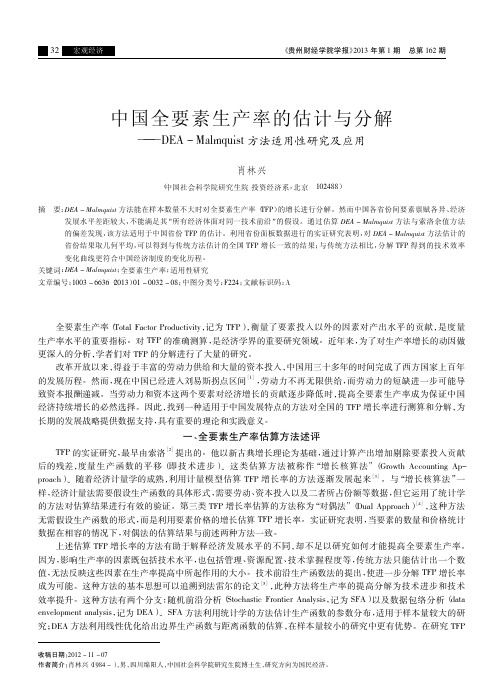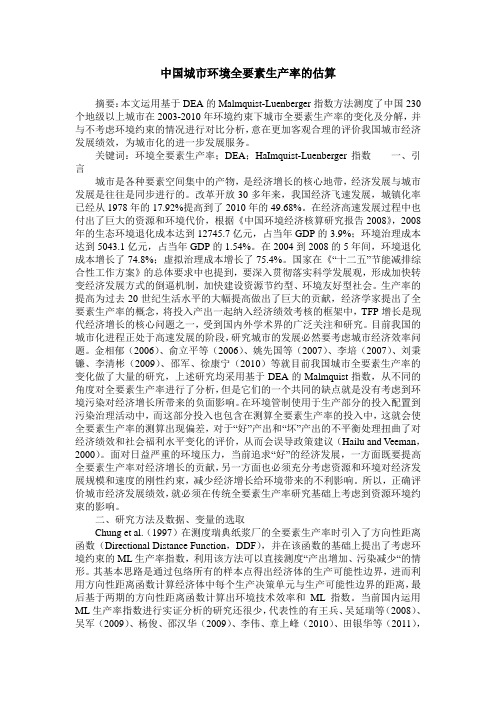中国全要素生产率和估算和分析
中国全要素生产率估算与分析

中国全要素生产率估算与分析概述全要素生产率(Total Factor Productivity, TFP)是衡量一个经济体整体生产效率的指标,也被视为衡量经济增长潜力的重要标志之一。
本文将对中国的全要素生产率进行估算与分析,探讨其对经济发展的影响。
什么是全要素生产率全要素生产率是指以生产要素(劳动力、资本等)的投入来推动产出增长的效率水平,即有效利用生产要素实现产出的能力。
全要素生产率的提高意味着经济在相同投入下创造了更多的产出,从而实现了经济增长。
全要素生产率的估算方法全要素生产率的估算通常通过计算生产函数的总因子生产率来实现。
总因子生产率是全要素生产率的一种计算方法,通过比较产出增长和生产要素(如劳动力、资本)的投入增长之间的差异来计算。
常见的估算方法1.柯布-道格拉斯生产函数法:假设生产函数呈现线性或凸函数形式,通过计算边际产出和边际投入之比来估算全要素生产率。
2.索洛增长模型:通过分析投入要素的组成和变化,以及技术进步对产出的影响,来估算全要素生产率。
3.生产函数前沿分析法:利用生产函数前沿技术和效率分析方法,测量总体和部门的全要素生产率。
中国全要素生产率的现状中国是世界上最大的发展中国家,全要素生产率对其经济发展具有重要意义。
根据统计数据,中国的全要素生产率在过去几十年中有所增长,但增速缓慢。
影响中国全要素生产率的因素1.技术进步:技术进步是促进全要素生产率提高的主要因素之一。
中国在技术创新方面取得了一定的成就,但仍面临着与发达国家的差距。
2.劳动力质量:劳动力质量对全要素生产率的提高具有重要影响。
中国的教育水平逐渐提高,但仍存在一些问题,如教育结构不合理和劳动力技能不足等。
3.资本投资:充分利用资本投资是提高全要素生产率的重要手段。
中国在基础设施建设和人力资本投资方面取得了进展,但与其他国家相比仍有差距。
4.制度环境:制度环境对全要素生产率的改善至关重要。
中国政府在近年来进行了一系列改革,以改善市场环境和促进创新,但仍面临挑战。
中国全要素生产率的测算及变动分析

中国全要素生产率的测算及变动分析作者:杨绍明来源:《财讯》2018年第21期采用索罗残差法,计算出平均资本产出弹性。
据此计算我国全要素生产率(TFP)增长率。
结果显示:我国1952年至2016年间TFP增长率剧烈波动,分解增长率后发现,资本仍是增长的主要动力。
索罗残差法资本产出弹性全要素生产率问题提出全要素生产率(Total FactorProductivity,TFP)是长期支撑经济体增长的重要因素,对其的测度具有较强的理论与现实意义。
易纲等(2003)对证明我国经济增长中存在效率提升。
郭庆旺和贾俊雪(2005)采用三种模型计算了我国TFP增长率,结果都表明经济的波动与TFP 增长率密切相关。
牛龙(2013)认为这近三十年间,我国经济增长的8.7%来源于劳动增加,49.4%来源于资本增加,41.8%来源于技术进步。
罗良文和梁圣蓉(2016)发现我国经济增长主要来源于资本投入,技术进步的贡献只占到百分之十几。
已有文献的结论并不一致。
理论准备以Cobb-Douglas生产函数为基础的模型推导过程,主要分为两步:(1)计算资本与劳动的产出弹性。
Yt=AtKtaLt(1-a)(2.1)Yt、Al、Kt、Lt为第t年产出、资本存量、劳动力数量;a为资本产出弹性整理并化简公式(2.1):数据处理本文以1952年至2016年为研究区间。
总产出 Yt为GDP,用CPI换算成以1952年价格;劳动Lt为全国就业人员;资本Kt为我国的资本存量,但此数据需要进行测算。
采用永续盘存法(Kt=(1-8)Kt-1+lt/Pt,It、Pt为第t年固定资产投资、固定资产价格指数;δ为固定资产折旧率)测算资本存量。
It采用固定资本形成总额数据。
Pt采用借鉴张军(2004)介绍的方法构的造固定资本形成总额指数。
基期资本存量Ko采用单豪杰(2008)测算的结果342亿元(1952年价)。
δ采用陈昌兵(2014)计算的结果5.65%。
中国全要素生产率的估计与分解_DEA_Malmquist方法适用性研究及应用

经济持续增长的必然选择。因此, 找到一种适用于中国发展特点的方法对全国的 TFP 增长率进行测算和分解, 为 长期的发展战略提供数据支持, 具有重要的理论和实践意义。
全要素生产率( Total Factor Productivity, 记为 TFP ) , 衡量了要素投入以外的因素对产出水平的贡献, 是度量 生产率水平的重要指标。对 TFP 的准确测算, 是经济学界的重要研究领域。近年来, 为了对生产率增长的动因做 更深入的分析, 学者们对 TFP 的分解进行了大量的研究。 改革开放以来, 得益于丰富的劳动力供给和大量的资本投入 , 中国用三十多年的时间完成了西方国家上百年
32
宏观经济
《贵州财经学院学报》 2013 年第 1 期
总第 162 期
中国全要素生产率的估计与分解
*
— — —DEA - Malmquist 方法适用性研究及应用
肖林兴
( 中国社会科学院研究生院 投资经济系, 北京 102488 ) 摘 要:DEA - Malmquist 方法能在样本数量不大时对全要素生产率( TFP) 的增长进行分解。然而中国各省份间要素禀赋各异 、 经济 “所有经济体面对同一技术前沿 ” 发展水平差距较大, 不能满足其 的假设。 通过估算 DEA - Malmquist 方法与索洛余值方法 的偏差发现, 该方法适用于中国省份 TFP 的估计。利用省份面板数据进行的实证研究表明, 对 DEA - Malmquist 方法估计的 省份结果取几何平均, 可以得到与传统方法估计的全国 TFP 增长一致的结果;与传统方法相比, 分解 TFP 得到的技术效率 变化曲线更符合中国经济制度的变化历程 。 关键词:DEA - Malmquist;全要素生产率;适用性研究 文章编号:1003 - 6636 ( 2013 ) 01 - 0032 - 08 ;中图分类号:F224 ;文献标识码:A
中国全要素生产率估算与分析

中国全要素生产率估算与分析根据最新的统计数据,中国的全要素生产率一直处于较快增长的状态。
在过去几十年里,中国经济实现了快速增长,并且不断提高了生产率水平。
这主要得益于中国不断推进经济改革,加大对技术创新的投入,改善了生产要素的配置和利用效率。
通过对中国全要素生产率的估算与分析,我们可以发现一些特点和趋势。
首先,在产业结构升级和技术创新的推动下,中国的全要素生产率持续提升。
在传统产业向现代产业转型的过程中,劳动力的素质和技能不断提高,技术水平逐步提升,资本投入和利用效率逐渐改善,这些都对全要素生产率的增长起到了支撑作用。
其次,中国的全要素生产率在不同地区和行业之间存在较大的差异。
东部沿海地区的全要素生产率水平相对较高,而中西部地区的全要素生产率则相对较低。
在行业方面,高科技产业和服务业的全要素生产率明显高于传统制造业和农业。
这表明中国地区之间和行业之间的发展不平衡问题依然存在,需要进一步加强政策引导和扶持。
综上所述,中国的全要素生产率在不断增长,但仍面临着不平衡的地区和行业发展状况。
未来,中国需要加大对技术创新的投入,促进产业结构升级和转型升级,加强对全要素生产率的测算和分析,以实现经济高质量发展和可持续增长。
中国全要素生产率(TFP)的估算与分析是我们了解中国经济的发展与竞争力的重要途径。
全要素生产率是衡量经济效率和创新能力的一个关键指标,它是指在市场运作的条件下,多种生产要素共同参与生产,经济体系产出的增长除了由劳动力和资本进步外,还包括了一种由全要素生产率技术变动所引起的增长。
简而言之,全要素生产率代表了除了劳动力和资本外,其他要素(如技术、管理等)对经济增长的贡献。
中国经济的快速发展在过去几十年里取得了巨大成功,同时也在全要素生产率上取得了显著成绩。
按照最新的统计数据,中国的全要素生产率一直在持续增长。
这种增长主要是由于中国政府在长期经济改革方面的成功举措,以及在技术创新和知识产权保护方面的努力。
中国省域绿色全要素生产率测算及分析

一、引言随着我国经济进入新阶段,绿色发展在国家发展战略中的地位日益凸显。
十九大报告明确指出我国经济已转向高质量发展阶段,绿色发展是核心内容之一。
绿色发展的实质就是更多地将生产投入转化为绿色产出,尽可能规避减少污染物的产生,重点在于不断提升和改善绿色生产发展水平和效率。
因此,良好地测度分析绿色发展效率是定位开展绿色发展工作的前提条件,同时也对我国统筹经济环境协调发展、制定生态环保政策具有重要指导意义。
二、文献综述绿色全要素生产率(GTFP)由Chung最早在常规经济增长分析框架下嵌入污染物排放衡量非期望产出部分而延伸产生。
区别于全要素生产率(TFP),GTFP在TFP测度基础上引入衡量能源投入、污染物产出等诸多因素进一步构建形成更为复杂、全面的指标加以衡量。
当前我国对GTFP测度研究的文献相对丰富,主要差异集中在测度办法及指标选取两个方面。
刘晓洁等(2018)采用混合距离的EBM模型测算发现中国各省份GTFP呈上升趋势,东、中、西区域呈现α和β收敛;朱金鹤等(2019)采用DEA方法测算四种中国各省份的GTFP,发现GTFP均呈现上升态势,主要动因为绿色技术进步指数;李占风等(2019)采用CRS乘数模型,测算并分解城市GTFP;朱广印等(2020)采用非期望产出综合指标基于超效率SBM模型测度中国各省份GTFP,结果呈现上升趋势,出现持续技术效率优化现象;孟望生等(2020)采用二氧化硫、烟尘、废水为非期望产出基于NDDF方法测度GTFP,发现我国各省区GTFP有所提高,区域间差异化加大;孙亚男等(2020)采用三阶段SP-DEA测算分析GTFP,研究发现中国GTFP呈现整体上升,且具有“区块链”特征的俱乐部收敛。
综合上述研究,本文以资本、劳动和能源三方面选取投入指标,选取国内生产总值(GDP)和常见的“三废”为产出指标,采用非径向、非角度SBM距离函数下的ML指数法对2003~ 2017年中国省域绿色全要素生产率进行测度分解,通过全国整体、省域和区域三个层面分析变动特点。
中国城市环境全要素生产率的估算

中国城市环境全要素生产率的估算摘要:本文运用基于DEA的Malmquist-Luenberger指数方法测度了中国230个地级以上城市在2003-2010年环境约束下城市全要素生产率的变化及分解,并与不考虑环境约束的情况进行对比分析,意在更加客观合理的评价我国城市经济发展绩效,为城市化的进一步发展服务。
关键词:环境全要素生产率;DEA;HaImquist-Luenberger指数一、引言城市是各种要素空间集中的产物,是经济增长的核心地带,经济发展与城市发展是往往是同步进行的。
改革开放30多年来,我国经济飞速发展,城镇化率已经从1978年的17.92%提高到了2010年的49.68%。
在经济高速发展过程中也付出了巨大的资源和环境代价,根据《中国环境经济核算研究报告2008》,2008年的生态环境退化成本达到12745.7亿元,占当年GDP的3.9%;环境治理成本达到5043.1亿元,占当年GDP的1.54%。
在2004到2008的5年间,环境退化成本增长了74.8%;虚拟治理成本增长了75.4%。
国家在《“十二五”节能减排综合性工作方案》的总体要求中也提到,要深入贯彻落实科学发展观,形成加快转变经济发展方式的倒逼机制,加快建设资源节约型、环境友好型社会。
生产率的提高为过去20世纪生活水平的大幅提高做出了巨大的贡献,经济学家提出了全要素生产率的概念,将投入产出一起纳入经济绩效考核的框架中,TFP增长是现代经济增长的核心问题之一,受到国内外学术界的广泛关注和研究。
目前我国的城市化进程正处于高速发展的阶段,研究城市的发展必然要考虑城市经济效率问题。
金相郁(2006)、俞立平等(2006)、姚先国等(2007)、李培(2007)、刘秉镰、李清彬(2009)、邵军、徐康宁(2010)等就目前我国城市全要素生产率的变化做了大量的研究,上述研究均采用基于DEA的Malmquist指数,从不同的角度对全要素生产率进行了分析,但是它们的一个共同的缺点就是没有考虑到环境污染对经济增长所带来的负面影响。
中国全要素生产率估算与分析
中国全要素生产率估算与分析中国的全要素生产率(Total Factor Productivity,TFP)是指在一个给定的生产过程中,单位产出所需的全部要素投入(劳动、资本和技术)与实际产出之间的比率。
它是衡量一个国家或地区经济增长和生产效率的重要指标。
中国的全要素生产率估算与分析可以从以下几个方面进行。
首先,中国的全要素生产率水平。
根据统计数据显示,中国的全要素生产率呈现出逐年提高的趋势。
这是由于中国在过去几十年中不断进行的经济和创新,以及技术进步的不断推动。
中国的全要素生产率水平已经取得了一定的突破,但仍然相对较低,与发达国家相比仍有较大差距。
其次,中国的全要素生产率增长速度。
在过去几十年的经济中,中国的全要素生产率增速较快。
这是由于中国不断开放,引进和应用先进的生产技术和管理经验,提高了生产效率。
然而,随着经济发展进入新常态,中国的全要素生产率增长速度已经放缓,需要进一步深化,加大创新力度,推动全要素生产率的提高。
再次,中国全要素生产率的影响因素。
中国全要素生产率的提高受到多种因素的影响,包括人力资本、技术创新、经济体制、市场竞争等。
中国在人力资本方面还存在不足,包括教育水平的提高、职业培训的加强等。
同时,中国在技术创新方面也需要加大投入,培育创新型企业和创新型人才,推动技术进步和全要素生产率的提高。
最后,中国全要素生产率提高的政策建议。
为了提高中国的全要素生产率,可以采取一系列政策措施。
首先,加强教育和职业培训,提高人力资本的质量和数量。
其次,加大对科技创新的支持,鼓励企业增加技术投入,促进技术进步。
同时,通过深化经济体制,减少市场垄断,增加市场竞争,提高资源配置效率。
此外,还可以通过减少行政审批、降低企业税负等举措,为企业创新提供更好的环境。
综上所述,中国的全要素生产率是衡量一个国家经济增长和生产效率的重要指标。
中国的全要素生产率水平不断提高,但仍然相对较低,需要进一步深化,加大创新力度,推动全要素生产率的提高。
我国全要素生产率估算及影响因素研究
我国全要素生产率估算及影响因素研究全要素生产率,又称为全要素生产率效率或全要素生产率指数,是反映生产要素利用效果的综合指标。
而全要素生产率的估算及其影响因素的研究,则是经济学领域的一项重要研究。
我国的全要素生产率估算及影响因素研究始于上世纪80年代,随着中国经济的快速发展和国内经济学研究的逐步深入,这一领域也日趋成熟和完善。
下面将从估算方法、影响因素等方面进行简要分析。
一、估算方法要素输入有两种:资本输入和劳动输入。
要素产出也有两种:产出量和劳动生产率。
那么,对于全要素生产率的估算,通常采用以下公式:TFP=(技术进步因素)*(总要素产出量)/(总要素投入量)其中,技术进步因素是通过计算总要素生产率的增长率所得到的,因此全要素生产率的估算可以看作是计算总要素生产率的增长率所得到的。
而总要素生产率的计算上通常采用了三种方法:重平均法、边际分析法和概率统计方法。
不同的方法有不同的优点和缺点,对于研究者来说,需要根据实际情况来选择合适的方法。
二、影响因素全要素生产率受众多因素的影响,包括技术水平、市场开放度、国际贸易、政府政策等。
下面分别从几个方面进行详细分析。
1、技术水平影响技术进步不仅是影响全要素生产率的重要因素之一,也是经济发展的核心驱动力。
我国近几年来积极推动科技创新和技术升级,增强了产业的自主创新能力和科技水平,促进了全要素生产率的提升。
2、市场开放度影响市场开放度是指国家对外部经济与贸易的开放程度,它与全要素生产率的关系十分密切。
开放贸易可以扩大市场规模,提高资源配置的效率和国内产业的竞争力,有利于全要素生产率的提高。
3、国际贸易影响国际贸易中的资源配置和技术转移是推动全要素生产率提高的重要因素。
通过国际贸易,我国可以获取到国际市场上的贸易优势,借鉴其他国家的先进技术和管理经验,有助于提高自身的生产效率和竞争力。
4、政府政策影响政府政策在改进全要素生产率方面起到了很大的作用。
政府通过出台相关政策,加强资源配置和技术创新的支持和引导,优化企业经营环境和人才培养,有助于提高全要素生产率。
我国全要素生产率估算及影响因素分析
我国全要素生产率估算及影响因素分析作者:杨营营来源:《现代商贸工业》2017年第36期摘要:以参数方法中的生产函数法对我国1996-2015年的数据进行分析,找出我国经济增长的影响因素,并针对这些影响因素提出政策建议。
结果表明国外技术引进、技术自主创新和制度变迁仍然是影响我国全要素生产率的主要因素,其中,制度因素是影响我国全要素生产率的最主要因素。
关键词:全要素生产率;估算;影响因素中图分类号:F2文献标识码:Adoi:10.19311/ki.1672-3198.2017.36.0060 引言全要素生产率是衡量单位总投入的总产量的生产率指标,即总产量与全部要素投入量之比。
它的研究有利于进行经济增长的源泉分析,是宏观经济学中反映经济增长的重要指标,近年来受到经济学者的广泛关注。
测算全要素生产率的方法大致分为参数方法和非参数方法两类。
1 我国全要素生产率的估算1.1 模型设定我们利用生产函数法具体估算我国1996-2015年的全要素增长率,相关数据主要来源于《中国统计年鉴》。
根据生产函数法的基本方程Y=AKαLβ,假设α+β=1,求得A。
在求全要素生产率之前需要先求得α,对于资本产出份额α,虽然计算劳动者报酬占GDP的比重可以得到劳动者产出份额,但是中国统计年鉴中并无按照收入法核算的GDP,因此我们采用对各省的收入法计算数据进行加总计算取平均数得到。
经过计算估计得到的劳动产出份额β大约为0.45。
经查文献,我们计算的结果与现有文献的估算结果大致相同,故本文采用α=0.55,β=0.45。
1.2 数据来源与指标选取1.2.1 产出数据Y本文采取的是我国国内生产总值GDP作为产出的数据,由于各年的价格不同,价格波动会对GDP产生影响,所以以1996年不变价格将历年GDP换算为以基期价格计算的数据。
1.2.2 劳动投入L劳动投入采用了各年从业人数的数量来度量。
严格来说,这一指标并不十分准确,因为劳动投入还与劳动力的质量和利用效率有关,仅仅通过从业人数度量不能完全反应劳动力对经济增长的贡献,但是根据数据的可获得性及公式的复杂程度考虑,只能采用从业人数作为劳动投入的衡量指标。
全国及区域全要素生产率变动分析
全国及区域全要素生产率变动分析全国及区域全要素生产率变动分析摘要:一直以来,C-D生产函数模型及在此基础上产生的索洛残差法在估算TFP及其增长率时得到广泛应用,笔者从模型的设定、数据的获取、参数估计等方面对该方法进行了系统分析、探讨和修正,在此基础上估算了全国及31个省1978年~2010年间的TFP及其增长率。
结果表明:中国的TFP增长率总体上处于较高水平。
分阶段看,2001年~2010年和1978年~1984年的TFP增长率明显较高。
分区域看,东部的TFP及其增长率都明显高于中部和西部。
各省区的TFP 与经济发展水平、TFP增长率与经济增长速度都有很强的正相关性。
关键词:全要素生产率;增长率;生产函数;弹性作者简介:叶宗裕(1962-),男,浙江江山人,浙江师范大学经济与管理学院教授,应用数学硕士,主要从事经济统计,计量经济模型及应用研究。
中图分类号:F061.5文献标识码:A文章编号:1006-1096(2014)01-0014-06收稿日期:2012-11-14一、问题的提出最近10多年来,许多学者研究了全要素生产率(TFP)及其相关问题。
包括全国或省际TFP及其增长率的测算、TFP的收敛检验、技术进步对经济增长的贡献分析、分析TFP与省区收入差距的关系等。
对TFP相关问题的研究,必需建立在对TFP的准确估算基础上。
虽然对全国或省际TFP的测算已有大量的研究成果发表,但许多研究在估算方法、资料的来源和处理等方面存在许多问题,估算结果的准确性不能令人满意。
关于TFP,学者们已经有了基本一致的观点:包括资本和劳动等投入要素之外的所有影响产出的因素。
虽然估算TFP的方法多种多样,但由于C-D生产函数模型中各变量和参数的含义明确、直观,结果易于理解,在估算TFP及其增长率时得到广泛应用。
本文从模型的设定、数据的获取、参数估计等方面对该方法进行了系统分析、探讨和修正,在此基础上估算了全国及31个省份1978年~2010年间的TFP及其增长率,并对结果进行了分析。
- 1、下载文档前请自行甄别文档内容的完整性,平台不提供额外的编辑、内容补充、找答案等附加服务。
- 2、"仅部分预览"的文档,不可在线预览部分如存在完整性等问题,可反馈申请退款(可完整预览的文档不适用该条件!)。
- 3、如文档侵犯您的权益,请联系客服反馈,我们会尽快为您处理(人工客服工作时间:9:00-18:30)。
Divisia indexes and rate of technical change
The linear transformation of the CCR ratio
for a representative solution
The dual to the linear transformation
Envelopment surface for the inputoriented CCR model
CRS, NIRS, and VRS
General statistics about the DEA bibliography database (Tavaresa, 2002).
DEA publications number by type.
DEA publications number by year
Total differentiation of with respect to time yields
Dividing through by y gives
Under profit maximization, output elassticity equals input Shares in total revenue:
Total factor productivity is the average product of all inputs, it is the ratio of the output to an index of inputs. Let the index of inputs be denoted as X. Then total factor productivity (TFP) is
CCR 模型 (Charnes, Cooper, & Rhodes, 1978)
BCC 模型(Banker, Charnes, & Cooper, 1984)
ADD 模型 (Charnes, et al, 1985)
DEA模型与回归模型的比较
The CCR ratio model (input oriented, 1978)
or
Divisia input index
应用实例:技术进步与总量生产函数 (Solow, 1957)
增长核算公式
Technical change is a shift in the production function
(3) 管理(技术)效率与全要素生产率
Farrell (1957)技术效率度量 一般化的Farrell技术效率度量 (Førsund & Hjalmarsson, 1979) 数据包络分析(DEA)模型
Farrell measure
Technical Efficiency
(1957)
a road map
Technical Progress (1957)
Shephard
Distance Function (1970)
Stochastic frontier
Deterministic
Technical efficiency (Farrell, 1957) Technical progress (Sollow, 1957) Distance function (Shephard, 1970) DEA (Charnes, Cooper, & Rhodes, 1978). TFP decomposition (Nishimizu & Page, 1982) Malmquist index (Caves, et. al, 1982) Malmquist TFP index decomposition (Färe et al, 1994)
•
TFP T(x,t) under CRS
以成本在产值中的比重加权: Divisia index
(2) 生产函数与技术进步
A stable relationship between output, inputs, and time exists:
Rate of technical change is defined as:
中国全要素生产率估算与分析
内容提要
1. 生产率概念的由来 2. 全要素生产率的估算与拆分 3. 全要素生产率与企业改革 4. 全要素生产率与可持续经济增长 5. 中国省际全要素生产率增长变化的实证分析 6. 前苏联和亚洲四小龙的案例 7. 影响全要素生产率增长的因素 8. 中国经济增长模式的转变
一、生产率概念的由来: (1) 投入产出率
The Output-Oriented CCR model
Suporting hyperplane for the outputoriented CCR model
Restrictions on parameters in DEA
CRS: no restrictions VRS:
Nonincreasing returns to scale (NIRS):
Author statistics
二、全要素生产率的估算与拆分
增长核算法 (Devisia Index) 生产函数估算法
平均生产函数法(技术进步) 前沿生产函数法(技术效率)
Malmquist 指数法拆分(panel data)
技术进步 技术效率改善 规模效率变化
技术效率、距离函数、 DEA、和 Malmquist生产率指数之间的关系
TFP=y/X
Differentiating both sides logarithmically
with respect to time gives
•
TFP
d ln y d ln X
••
y X
dt
dt
以成本份额加权平均
If define Notice
•
TFP
dlnຫໍສະໝຸດ ydtj•
(wj x j / c) x j
